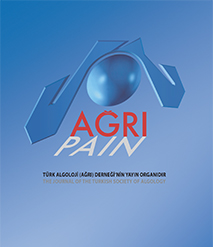Non-Invasive Peripheral Nerve Neuromodulation in Diabetic Neuropathic Pain, a Randomised Controlled Trial
Gevher Rabia Genç Perdecioğlu, Gökhan Yildiz, Mehlika Panpallı Ateş, Damla Yürük, Taylan AkkayaEtlik City HospitalObjectives: Diabetic neuropathic pain (DNP) is one of the most common and challenging complications of diabetes mellitus and often results in significant distress and impaired quality of life. Pulsed radiofrequency (pRF) treatment has gained traction in recent years as an effective intervention for the management of chronic pain. Therefore, noninvasive pRF (NipRF) has been introduced as an innovative treatment that promises to provide pain relief without invasiveness. In this study, we aimed to evaluate the efficacy of NipRF in the treatment of DNP.
Material and Methods: This double-blind, randomized, controlled study included 64 patients with DNP and distal symmetric polyneuropathy refractory to multiple medical therapies, as confirmed by electroneuromyelography (ENMG). Participants were divided into two groups: one received NipRF treatment via a transcutaneous electrode (treatment group) and the other received a sham electrode (sham group) without radiofrequency. Pain levels were measured using the visual analog scale (VAS) and Self Leeds Assessment of Neuropathic Symptoms and Signs (S-LANSS) before treatment and at 4 and 12 weeks after treatment.
Results: The treatment group experienced significant reductions in the VAS and S-LANSS scores at 1 and 3 months post-treatment (p<0.001). The sham group showed a moderate, but not statistically significant, decrease at week 4, with scores reverting to baseline by week 12.
Conclusions: NipRF therapy may be a good option for DNP management. Its non-invasiveness and low risk of adverse events make it a good alternative to interventional and drug therapies.
Makale Dili: İngilizce





